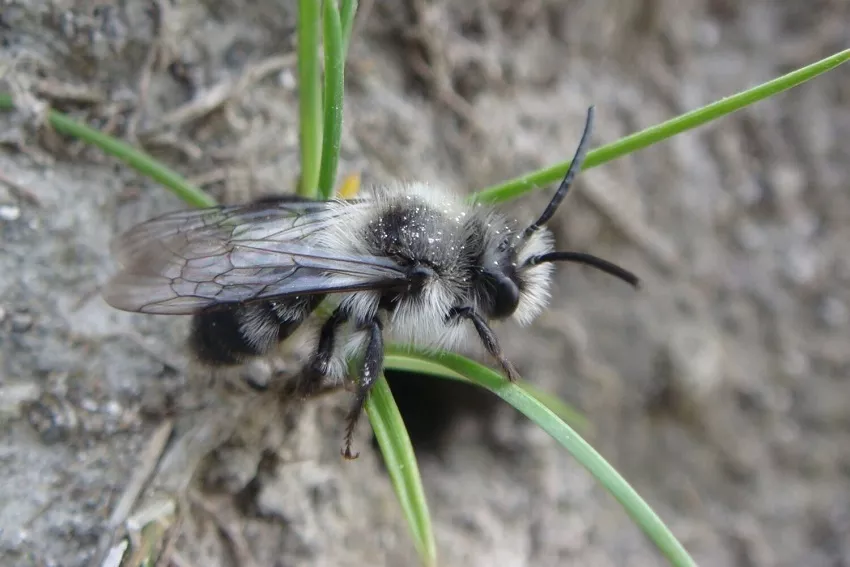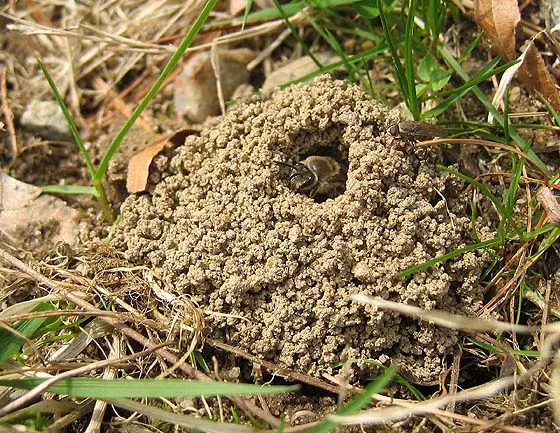As I became more and more interested in bees, I wondered about the many different species of bees that exist in the world. Once, in early spring, I noticed another species of bee. Because of this, I started to study mountain bees and learn about their behavior and habitat.

What Are Mining Bees?
Mining bees are solitary bees that build their nests in burrows.
Do Mining Bees Sting?
Yes, mining bees sting, but they are so small that they can barely penetrate our skin. Mining bees do not swarm and are generally not aggressive. This will be a mild feeling in case of a mining bee sting. They belong to the genus Andrena, and you can also call them digging bees.
Mining bees are fascinating creatures with interesting nesting habits that pose little threat to us.
On the contrary, they are of great benefit to us humans in many ways, and it is worth taking some time to learn about them.
Does Beeswax Clog Pores? Is Beeswax Good For Your Skin?
Nesting Of Mining Bees
Mining bees build their nests underground by building tunnels. To construct these tunnels efficiently, they prefer sandy or soft soils that are easier to drill into. They also tend to choose fairly bare areas, so they have less basic work to do. Occasionally they will choose native adobe or soft mortar to nest in older houses.
Underground nests usually consist of a main tunnel with side branches from which small, oval to round larval cells, called brood cells, are excavated. Nests are dug only by females. She uses her front legs to dig the main tunnel and her stomach and legs to push the dirt out of the dug holes.
While nest structures vary by species, tunnels are typically 7.8 to 23.6 inches deep, with entrances about 1 inch wide. After burrowing, the female fills each cell with pollen and nectar collected from early-blooming flowers and trees.
Since they are solitary, these underground caves are usually excavated by single females. Mine bees can gather together to dig their burrows, and the females of some species share a single entrance but have separate nests underground. Seen from above, the group of nests can give the impression of a social event. If the nests are left undisturbed, they can be occupied again in subsequent years.
Life Cycle Of Mining Bees
Now that we know how mining bees build their nests, we can take a closer look at their life cycle. Female mining bees first collect pollen and nectar from flowers in early spring, then form them into a ball in each subterranean cell. This is how she feeds her future offspring. She makes multiple trips from the nest to nearby flowers, pollinating hundreds of flowers while she does the work.
Clover Honey Vs Regular Honey: What’s The Difference?
The female then lays eggs on the nectar and pollen she accumulates in the coelomocytes. She usually lays about five eggs and then dies. When the larva hatches, it eats the stored pollen and nectar. After hatching, the mining larvae survive and pupate in an underground nest locked up throughout the summer. They mature into adult bees in the fall, but stay in their rooms until spring, when they dig their way outside and soar into the air.
In the spring, when all the males are busy finding female mates, large numbers of mining bees can fly around. Sometimes even hundreds of males flew over the same area where their mothers had nested the year before. Male bees have no role in building nests or providing food for their offspring. After mating, the female searches for a place to build a nest, and her short life is used to care for the next generation, and the cycle begins again.

Are Mining Bees Difficult To Identify?
There are about 450 species of mining bees in North America alone, and it’s hard to spot them by appearance alone. While some species of mining bees look very much like honeybees, they are generally multi-colored, some appear furry, and others sparse. Since male bees do not collect pollen, they are not as hairy as female bees. Males are also shorter and narrower than females.
The best way to identify mining bees is to observe their underground nesting habits, which I have outlined above. Spotting tiny piles of volcanic dirt on your flower beds or lawn that look more like worm droppings is another good sign that mining bees are active. Especially in the spring, when the mining bees appear, their humming can be very noticeable. Male mining bees buzz loudly in tunnels to attract females’ attention.
Light Honey Vs Dark Honey: Differences, Uses, Appearance, Taste
What Are The Benefits Of Mining Bees?
Mining bees aerate our soil through their nesting habits. Aeration allows air, water and nutrients to reach the roots of plants, which means they grow more vigorously. Especially our backyard lawns tend to become compacted, which means grass roots don’t get what they need to grow well. The tunnels built by the mining bees help keep the soil fertile and productive. It is also worth noting that digging by mining bees does not damage vegetation or plant roots in any way.
Like all bee species, mining bees are important pollinators. In fact, they are one of the main natural pollinators of cultivated and wild blueberries, which happen to be my favorite fruit! Although bees have been “domesticated” by humans and are now used for the majority of commercial pollination of food crops, native mining bees were originally the main pollinators of early flowering crops such as apples.
Do Mining Bees Collect Pollen From Only One Type Of Flower?
Bees that feed on a variety of pollen from different plant species are called polycrystalline bees. They feed on flowers of all shapes and sizes and many different types of plants. Honey bees are a good example of polycrystalline bees, as they prefer to collect pollen from a wide variety of flowers throughout the season.
On the other hand, solitary bees are usually oligomeric, and the andrena bees (mining bees) are no exception. The oligomeric bee is a bee that is very picky about its food, which means it will only collect pollen from a selected number of plant species. Often these plants are very closely related and belong to the same family and sometimes even the same genus.
In fact, some species of Andreena bees are monocytic, which means they collect pollen from only a single plant. For example, the gray-backed mountain bee Andrena vaga is a solitary bee species found in much of Europe that feeds exclusively on pasture pollen.
What Happens When You Add Honey To Hot Tea? Does Honey Lose Nutrients?
So when a plant becomes rare or extinct, so do its pollinators. When individual elements are destroyed, a domino effect of destruction spreads through the ecosystem.
How To Protect Mining Bees?
Because they nest underground, mining bees are particularly vulnerable to aggressive farming. Methods such as ploughing, slicing and shoveling can damage the nests of the mining bees, resulting in the loss of an entire generation of bees.
Mining bees prefer places that can withstand extreme weather from shrubs or trees, so a completely barren site is obviously not good for them. On the other hand, covering everything with heavy mulch is also detrimental to Andrena bees because the females cannot dig into the ground and build burrows through the mulch.
Like all bees, mining bees need garden flowers to provide the pollen they need for food. Female foragers expend a lot of energy to build their nests and gather supplies for their offspring, so they need a steady supply of pollen and nectar to power their activities. Honeybees benefit from a diverse and rich selection of native plants because of the plants they have co-evolved. The more varieties of crops you grow on your land, the more likely you are to meet the needs of a wider variety of bees.
You can maintain a bee-safe yard by avoiding pesticides and pesticides that could harm or kill your local bee population. Insecticides can easily kill Andreena bees, and herbicides can kill the plants they depend on. Maintaining a natural, pesticide-free garden with a variety of plants is the best way to attract and retain the most native bees.
Does Honey Freeze? What Happens When You Freeze Honey?
Mining bees are usually most active during the short period of spring. If possible, leave them alone to spend their busiest time! The pleasant presence of their buzz doesn’t last long, so you might even appreciate it every year as it arrives.
Related Questions
Do Mining Bees Produce Honey?
Unlike bees, mining bees do not make honey. They store tiny amounts of nectar and pollen for the larvae to eat. There is no honey production and no comb production.
How To Get Rid Of Mining Bees?
Why do this and why harm this beautiful creature that is neither offensive nor harmful to humans? Mining bees are an essential part of a balanced ecosystem and is important for pollinating our food crops? I encourage you to read more about them and you will love them too.
